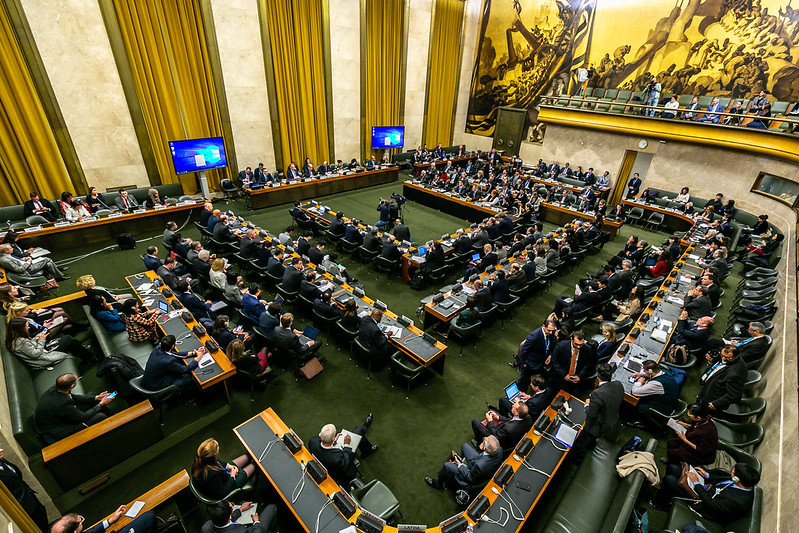Breadcrumb

EXPERTS MEETINGS OF TWO CCW PROTOCOLS FOCUS ON STRENGTHENING THEIR IMPLEMENTATION

The humanitarian impact caused by Improvised Explosive Devices (IED) was one of the many issues discussed by a group of experts of the States parties to Amended Protocol II to the 1980 Convention on Certain Conventional Weapons (CCW), which highlighted efforts to protect civilians from their use and the importance of preventing such incidents from happening. Drawing on various national experiences on IED incidents documented by States and learning from the work of international organizations and regional institutions to counter the use of IED, the experts focused on gaining a broader understanding on the scale of the problem and on the growing trend in this area.
Efforts at preventing and remedying the severe post-conflict humanitarian problems caused by Explosive Remnants of War (ERW) were also addressed by the experts. Casualties resulting from ERW are higher than those from cluster munitions or landmines. CCW Protocol V seeks to address the post-conflict remedial measures to minimize the effects and the risk posed by ERW. The topics discussed included clearance, removal or destruction of ERW; cooperation and assistance among States and organizations; generic preventive measures; recording the use of explosive ordnance during an armed conflict; national reporting; and assistance to victims.
These discussions took place in the Group of Experts of the States parties to CCW Amended Protocol II (AP II) on Prohibitions and Restrictions on the Use of Mines, Booby-Traps and Other Devices and the Meeting of Experts of the States parties to CCW Protocol V on Explosive Remnants of War from 8 to 12 April 2013 at the Palais des Nations, Geneva. The experts meetings were intended to further strengthen the implementation of both treaty regimes under the umbrella of the CCW.
The AP II Group of Experts (8 – 9 April) was presided by Ambassador Luis Gallegos of Ecuador in his capacity as President-designate of the Fifteenth Annual Conference of the High Contracting Parties to AP II, while the Protocol V Meeting of Experts (10 – 12 April) was presided by Ambassador Jan Knutsson of Sweden as President-designate of the Seventh Conference of the High Contracting Parties to Protocol V. The substantive Coordinators and co-coordinators led the discussions on all the thematic issues during the two experts meetings. They represented Australia, Austria, Belarus, Belgium, Chile, Germany, Italy, Switzerland and Ukraine.
The Coordinators will report on the work done under their respective responsibilities to the Seventh Conference of the High Contracting Parties to Protocol V (11-12 November) and the 15th Annual Conference of the High Contracting Parties to Amended Protocol II (13 November 2013), respectively, at the Palais des Nations in Geneva.
Background
The CCW Protocol on Mines, Booby-Traps and Other Devices (Protocol II) was amended on 3 May 1996 at the First Review Conference of the States Parties to the CCW. The number of States that have notified the Depository of their consent to be bound by Amended Protocol II rose from 45 at the time of the First Annual Conference in 1999 to the current total of 98.
The CCW Protocol on Explosive Remnants of War (Protocol V) is the recent-most addition to the Convention and it is the first-ever multilateral agreement to deal with the problem of unexploded and abandoned ordnance. It establishes that States which participate in an armed conflict are responsible for all explosive remnants of war in territory under their control. Protocol V was adopted on 28 November 2003 and entered into force on 12 November 2006. The number of States parties has steadily increased since the First Conference from 35 in 2007 to the current total of 81. Cuba is the latest country to join Protocol V on 14 November 2012.
The 1980 Convention on the Prohibitions or Restriction of the Use of Certain Conventional Weapons Which May Be Deemed to Be Excessively Injurious or to Have Indiscriminate Effects (CCW) is an umbrella treaty, which houses five Protocols regulating different types of weapons, that can respond to advancements in weapons technology by adding more protocols if needed and takes into account developments in the nature and conduct of armed conflict.
For more information on the CCW and its Protocols please contact the CCW Implementation Support Unit ccw@unog.ch or consult the official website of the CCW http://www.unog.ch/ccw .
For use of the information media; not an official record
DC13/016E
